前言
单向数据流,父组件传给子组件的数据,子组件只能展示,不能修改,如果需要修改则需要emit事件让父组件修改
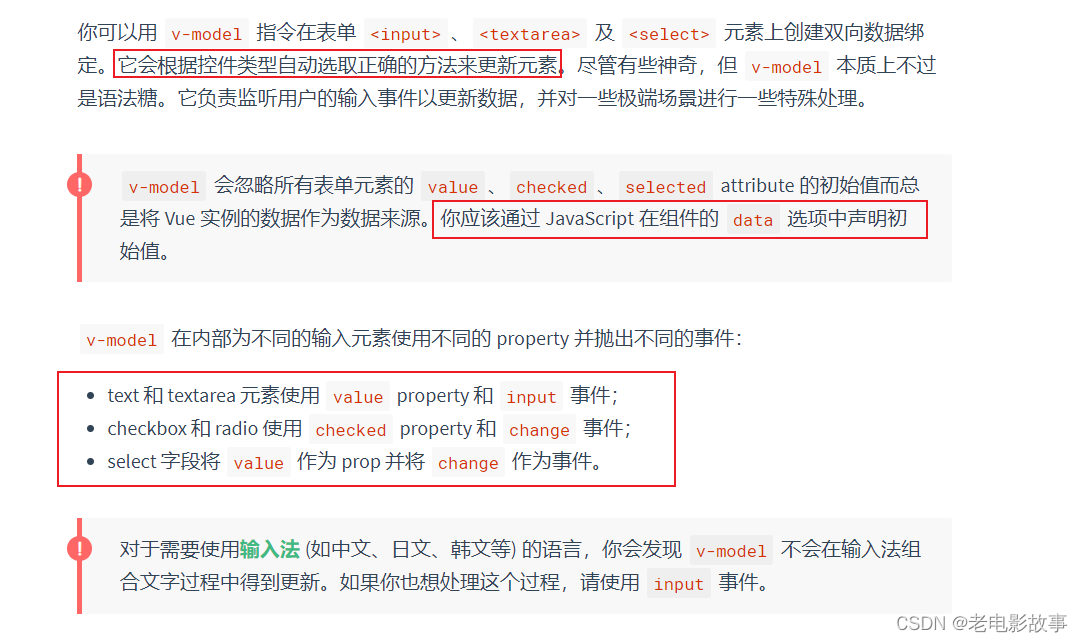
有些时候,一些组件并不是通过input来进行触发事件。也就是说value和input事件在大多数情况下能够适用,但是存在value另有含义,或者不能使用input触发的情况,这时候我们就不能使用v-model进行简写了。
就比如说选择框,绑定的值是checked而不是value,接收事件不是input而是change。
为了解决这个问题,尤雨溪在Vue2.2中,引入了model组件选项,也即是说你可以通过model来指定v-model绑定的值和属性。
vue2组件v-model.
1、vue2中双向绑定单个值(input)
<ChildComponent v-model = "title />
// 实际上是下面这种的简写
<ChildComponent :value = "title" @input = "title = $event" />
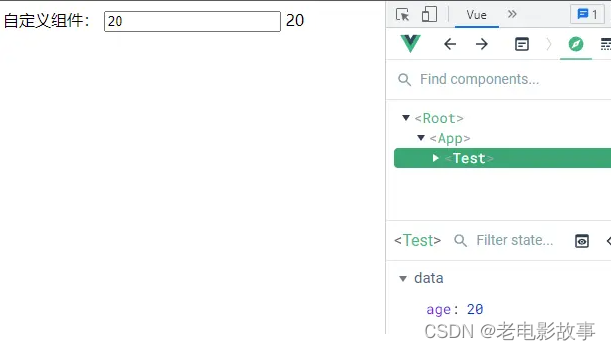
子组件:
<template>
<input type="text" :value="value" @input = "inputChange">
</template>
<script>
export default {
name: "CustomInput",
props: ['value'],
methods: {
inputChange(e) {
this.$emit('input', e.target.value)
}
}
}
</script>
父组件:
<template>
<div class="test">
<span>自定义组件:</span>
<CustomInput v-model="age"/>
// 等价
// <CustomInput :value="age" @input="changeAge"/>
{
{
age}}
</div>
</template>
<script>
import CustomInput from "./CustomInput";
export default {
name: "Test",
components: {
CustomInput,
},
data() {
return {
age: 20,
}
},
methods: {
changeAge(value) {
this.age = Number(value);
}
}
}
</script>
在vue2中,v-model相当于用value传递了绑定值,用@input事件接收了子组件通过$emit传递的参数。
2、vue2中双向绑定单个值(非input 设置model选项)
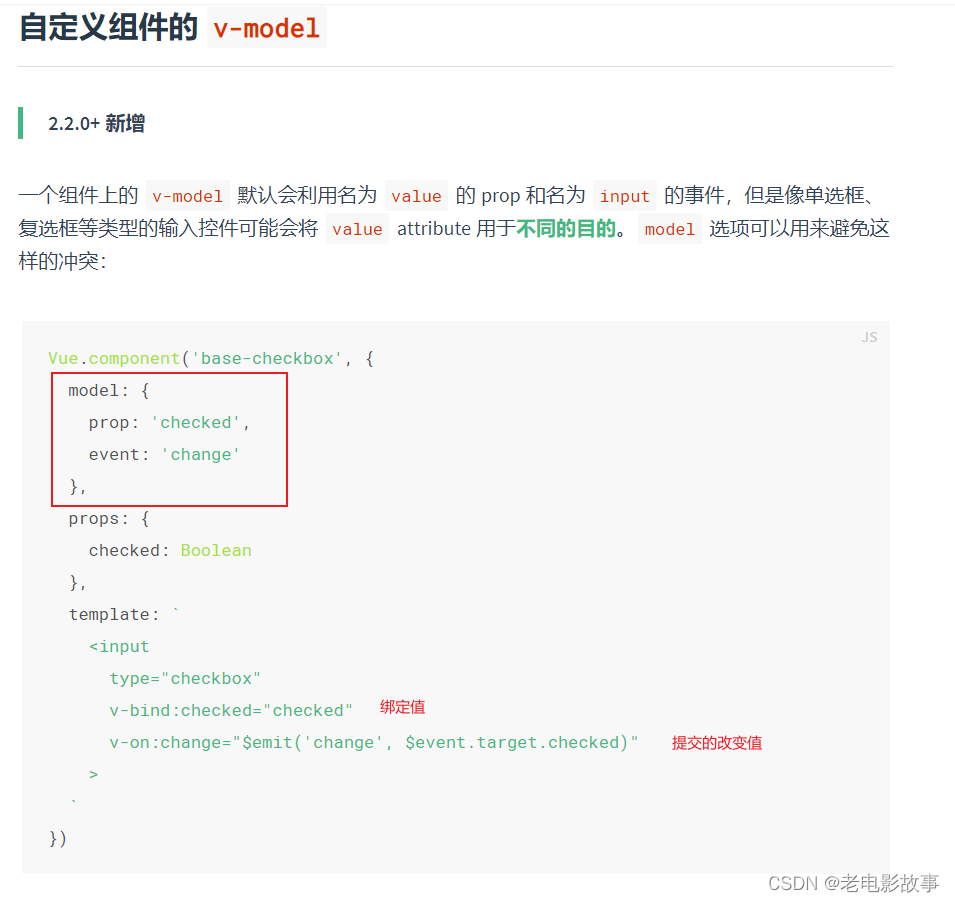
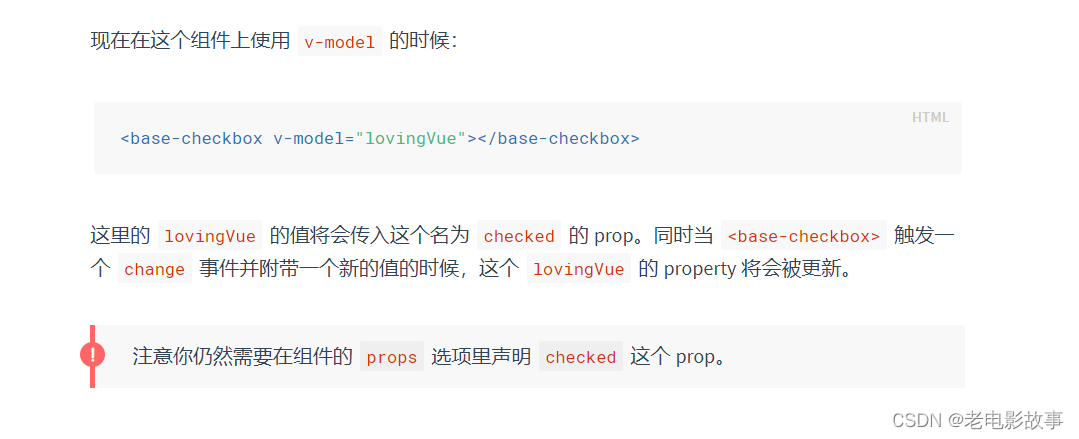
通过上面的代码,我们可以看到通过设置model选项,我们就可以直接使用指定的属性和事件,而不需要必须使用value和input了,value和input可以另外它用了。
3、vue2中双向绑定多个值
但是这样的话写起来很麻烦,而且v-model只能绑定一个值,这样的话我的组件封装不是只能改变一个值了,这样好像也不符合开发。
所以,再看下vue2文档
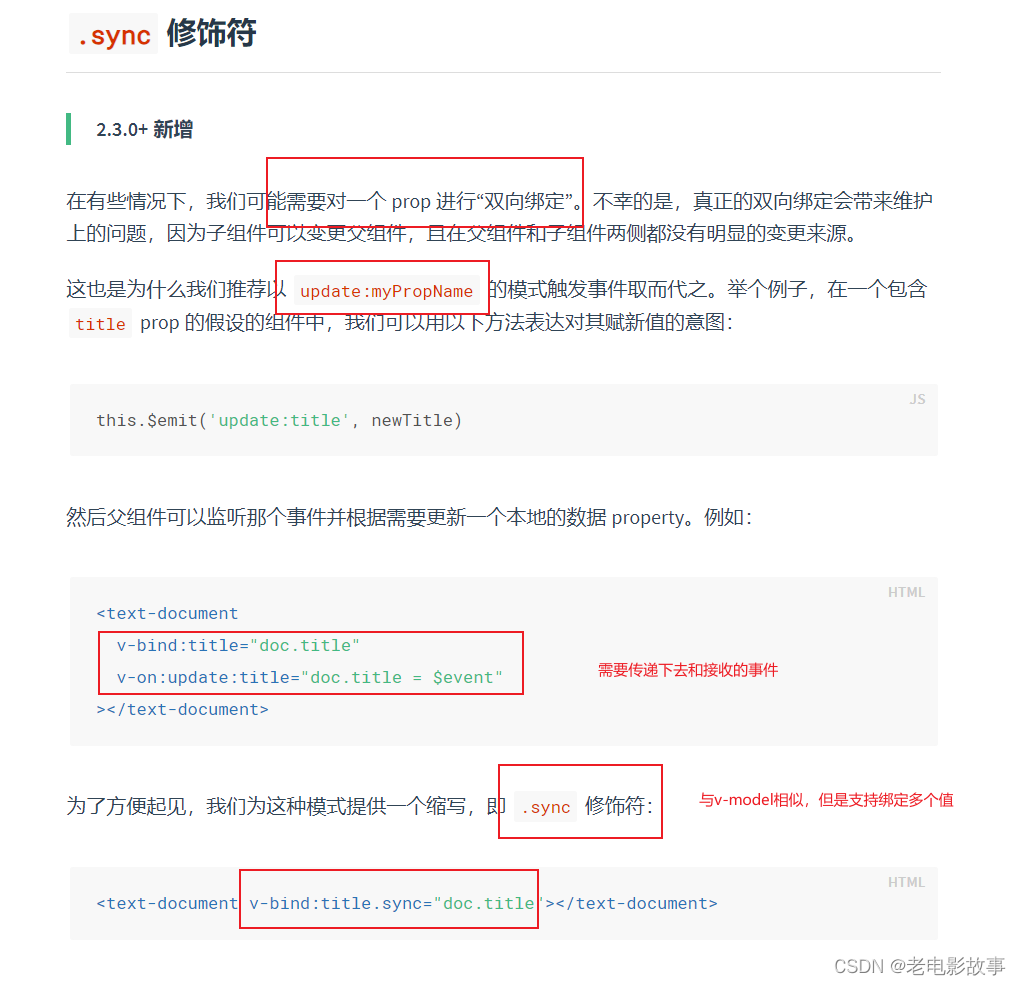
.sync和v-model类似,就是传递值和接收事件的简写。这样的话我们就可以不用写model了。直接告诉我更新哪个值。
注意哦

子组件:

父组件:

所以,绑定多个值,我们可以传递一个obj下去,使用v-bind.sync=‘obj’
再看一个例子:
子组件:
<template>
<div>
<input :value="value" @input = "inputChange">
<input :value="name" @input = "inputNameChange">
</div>
</template>
<script>
export default {
name: "CustomInput",
props: ['value', 'name'],
methods: {
inputChange(e) {
this.$emit('input', e.target.value)
},
inputNameChange(e) {
this.$emit('update:name', e.target.value);
}
}
}
</script>
父组件:
<template>
<div class="test">
<span>自定义组件:</span>
<CustomInput v-model="age" :name.sync="name"/>
// 此处v-model相当于:value="age" @input="age=$event"
</div>
</template>
<script>
import CustomInput from "./CustomInput";
export default {
name: "Test",
components: {
CustomInput,
},
data() {
return {
name: 'yn',
age: 20,
}
},
methods: {
// changeAge(value) {
// this.age = Number(value);
// }
}
}
</script>
是不是学着有点懵B,又是.sync 又是update:title的,vue3又删除了.sync,看下vue3的吧,更好用
vue3组件v-model
通过上面知道vue2.x中既然v-model的主要原因是由于value和input事件可能另有它用,那么我们可不可以直接使用另外的属性和方法,而不需要去通过model进行定义。
vue3中就实现了这个功能,v-model绑定的不再是value,而是modelValue,接收的方法也不再是input,而是update:modelValue。使用方法如下:
1、vue3中双向绑定单个值
v-model 在原生元素上的用法:
<input v-model="searchText" />
其实等价于下面这段:
<input :value="searchText" @input="searchText = $event.target.value"/>
而当使用在一个组件上时,v-model 会被展开为如下的形式:
<CustomInput
:modelValue="searchText"
@update:modelValue="newValue => searchText = newValue"
/>
在子组件中写法是:
export default defineComponent({
name:"CustomInput",
props:{
modelValue:String, // v-model绑定的属性值
},
setup(props, {
emit}) {
const updateValue = (e: KeyboardEvent) => {
emit("update:modelValue",targetValue); // 传递的方法
}
}
}
也就是说vue3中,value改成了modelValue,input方法了改成update:modelValue
再看个例子
子组件:
<template>
<div class='CustomInput'>
<input :value="modelValue" @input = "inputChange">
</div>
</template>
<script>
export default {
name: 'CustomInput',
props: {
modelValue: String,
},
setup(props, {
emit}) {
function inputChange(e) {
emit('update:modelValue', e.target.value)
};
return {
inputChange,
}
}
};
</script>
父组件:
<template>
<div class='test'>
<CustomInput v-model="name"/>
{
{
name}}
</div>
</template>
<script>
import CustomInput from './CustomInput';
import {
defineComponent, ref} from 'vue';
export default defineComponent({
name: 'test',
components: {
CustomInput
},
setup() {
const name = ref('zm');
return {
name
}
}
});
</script>
2、vue3中双向绑定多个值
例子1:
<UserName
v-model:first-name="first"
v-model:last-name="last"
/>
<script setup>
defineProps({
firstName: String,
lastName: String
})
defineEmits(['update:firstName', 'update:lastName'])
</script>
<template>
<input
type="text"
:value="firstName"
@input="$emit('update:firstName', $event.target.value)"
/>
<input
type="text"
:value="lastName"
@input="$emit('update:lastName', $event.target.value)"
/>
</template>
例子2:
父组件:
<template>
<div class='test'>
<CustomInput v-model:name="name" v-model:age="age"/>
{
{
name}} {
{
age}}
</div>
</template>
<script>
import CustomInput from './CustomInput';
import {
defineComponent, ref} from 'vue';
export default defineComponent({
name: 'test',
components: {
CustomInput
},
setup() {
const name = ref('zm');
const age = ref(20);
return {
name,
age
}
}
});
子组件:
<template>
<div class='CustomInput'>
<input :value="age" @input = "inputChange">
<input :value="name" @input = "inputNameChange">
</div>
</template>
<script>
export default {
name: 'CustomInput',
props: {
name: String,
age: Number,
},
setup(props, {
emit}) {
function inputChange(e) {
emit('update:age', e.target.value)
};
function inputNameChange(e) {
emit('update:name', e.target.value);
}
return {
inputChange,
inputNameChange,
}
}
};
</script>
3、v-model参数
默认情况下,v-model 在组件上都是使用 modelValue 作为 prop,并以 update:modelValue 作为对应的事件。我们可以通过给 v-model 指定一个参数来更改这些名字:
<MyComponent v-model:title="bookTitle" />
那么在子组件中,就可以使用title代替modelValue
<!-- MyComponent.vue -->
<script setup>
defineProps(['title'])
defineEmits(['update:title'])
</script>
<template>
<input
type="text"
:value="title"
@input="$emit('update:title', $event.target.value)"
/>
</template>
也就是说,我们最终的使用方法是:
<ChildComponent v-model:title="title" />
// 或者
<ChildComponent :title="title" @update:title = "title = $event" />
再看个例子
父组件:
<template>
<div id="app">
<h1>Vue3中v-model的变化</h1>
<input type="text" v-model="name"/>
<p>{
{
name }}</p>
<!-- Vue2的写法 -->
<!-- v-model实际上就是:value和@input的语法糖 -->
<!-- 双向绑定多个属性的时候可以使用.sync关键字 -->
<CustomInput v-model="age" :name.sync="name"/>
<!-- Vue3的写法 -->
<CustomInput v-model:age="age" v-model:name="name"/>
</div>
</template>
<script>
import CustomInput from "../components/CustomInput.vue";
export default {
name: "App",
components: {
CustomInput
},
data() {
return {
name: "你好",
age: 20,
}
},
}
</script>
子组件:
<template>
<div class="custom-input">
<h1>自定义的input</h1>
<!-- Vue2的写法 -->
<input type="text" :value="value" @input="onInput" />
<input type="text" :value="name" @input="onNameInput" />
<!-- Vue3的写法 -->
<input type="text" :value="age" @input="onInput" />
<input type="text" :value="name" @input="onNameInput" />
</div>
</template>
<script>
import CustomInput from "../components/CustomInput.vue";
export default {
// Vue2的写法
props: ["value", "name"],
// Vue3的写法,直接接收绑定的参数
props: ["age", "name"],
// Vue3双向绑定单个属性时,可以使用modelValue来接收参数并更新,对应的触发事件为update:modelValue
props: ["modelValue"],
methods: {
onInput(e) {
// Vue2的写法
// 触发的事件只能是input
// e.target.value是字符串需要转换成数字
this.$emit("input", parseInt(e.target.value));
// Vue3的写法
this.$emit("update:age", e.target.value);
},
onNameInput(e) {
// 只能用update
this.$emit("update:name", e.target.value);
},
},
}
</script>
好了,到目前为止,我们介绍了vue2中的v-model的使用以及问题,vue3中v-model的新的使用语法。赶快去体验vue3的使用吧。